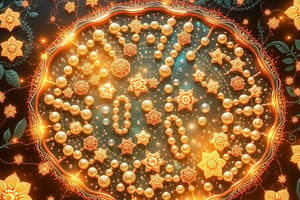Podcast
Questions and Answers
The cell membrane is made up of two layers of ______ with embedded proteins.
The cell membrane is made up of two layers of ______ with embedded proteins.
phospholipids
Who proposed the fluid mosaic model?
Who proposed the fluid mosaic model?
Singer and Nicolson
What is the function of carbohydrates in the cell membrane?
What is the function of carbohydrates in the cell membrane?
Cell-cell recognition and forming distinctive cellular markers
The biomolecule unscrambled as L I P I DS refers to ______.
The biomolecule unscrambled as L I P I DS refers to ______.
The biomolecule unscrambled as PR O T E I NS refers to ______.
The biomolecule unscrambled as PR O T E I NS refers to ______.
The biomolecule unscrambled as CA RBOH YD RA T E S refers to ______.
The biomolecule unscrambled as CA RBOH YD RA T E S refers to ______.
The type of lipid unscrambled as C HO L E S T E R O L is essential for ______.
The type of lipid unscrambled as C HO L E S T E R O L is essential for ______.
What are the main structural components of the cell membrane?
What are the main structural components of the cell membrane?
The cell membrane is impermeable to all substances.
The cell membrane is impermeable to all substances.
What is the primary role of proteins in the cell membrane?
What is the primary role of proteins in the cell membrane?
Flashcards are hidden until you start studying
Study Notes
Cell Membrane Overview
- Composed of a phospholipid bilayer interspersed with proteins, creating a barrier between the cell and its environment.
- The phospholipid structure allows for flexibility and functionality.
Fluid Mosaic Model
- Proposed by Singer & Nicolson in 1972.
- Concept describes the cell membrane as a dynamic and flexible structure with various components (lipids, proteins, carbohydrates) distributed unevenly.
Structural Components
-
Phospholipid Bilayer:
- Created by amphipathic molecules with hydrophilic (water-attracting) heads and hydrophobic (water-repelling) tails.
- Semi-permeable, allowing selective passage of substances.
-
Proteins:
- Integral proteins span the membrane and are involved in various functions such as transport and communication.
- Peripheral proteins are attached to the membrane surface and assist in signaling and structural roles.
- Key protein functions include receptor activity, channel formation, enzymatic reactions, and cell-cell recognition.
-
Carbohydrates:
- Located on the extracellular surface of the membrane.
- Types include glycoproteins (bound to proteins) and glycolipids (bound to lipids).
- Facilitate cell-cell communication, recognition, and interaction with pathogens.
-
Cholesterol:
- A lipid that helps to maintain membrane fluidity.
- Adjusts fluidity by decreasing it at high temperatures and increasing it at low temperatures.
Major Biomolecules in Cell Membranes
- Lipids: Group of organic compounds, insoluble in water, includes fats, waxes, oils, and hormones.
- Proteins: Made of amino acids, play crucial roles in structure, transport, and catalysis.
- Carbohydrates: Composed of carbon, hydrogen, and oxygen; includes sugars, starches, and fibers, serving as energy sources and structural components.
- Cholesterol: Waxy lipid vital for the production of hormones and maintaining cell membrane integrity.
Learning Outcomes
- Understand the structural components of the cell membrane and their relation to function.
- Design a fluid mosaic model to illustrate membrane components.
- Recognize biomolecules through unscrambling and identifying definitions and examples.
Studying That Suits You
Use AI to generate personalized quizzes and flashcards to suit your learning preferences.




